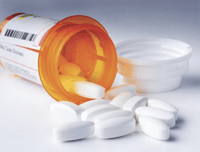|
How Should Comorbid Conditions Be Treated?
A fundamental principle emerging from scientific research is the need to treat comorbid conditions concurrently–which can be a difficult proposition ("Barriers to Comprehensive Treatment of Comorbidity"). Patients who have both a drug use disorder and another mental illness often exhibit symptoms that are more persistent, severe, and resistant to treatment compared with patients who have either disorder alone. Nevertheless, steady progress is being made through research on new and existing treatment options for comorbidity and through health services research on implementation of appropriate screening and treatment within a variety of settings (e.g., NIDA's Criminal Justice Drug Abuse Treatment Studies [CJ-DATS]).

Medications
Effective medications exist for treating opioid, alcohol, and nicotine
addiction and for alleviating the symptoms of many other mental disorders. Most of these medications have not been studied in patients with comorbidities, although some may prove effective for treating comorbid conditions. For example, preliminary results of a recent study point to the potential
of using divalproex (trade name: Depakote)–an anticonvulsant
commonly used to treat bipolar disorder–to treat patients with comorbid bipolar disorder and primary cocaine dependence. Other evidence suggests that
bupropion (trade names: Wellbutrin,
Zyban), approved for treating depression and nicotine dependence, might also help reduce
craving and use of methamphetamine.
Most medications have
not been well studied in comorbid
populations or in populations
taking other psychoactive medications.
Therefore, more research
is needed to fully understand and
assess the actions of combined or
dually effective medications.

Behavioral Therapies
Behavioral treatment (alone or in
combination with medications)
is the cornerstone to successful
outcomes for many individuals
with drug use disorders or other
mental illnesses. And while behavior
therapies continue to be
evaluated for use in comorbid
populations, several strategies
have shown promise for treating
specific comorbid conditions ("Examples of Promising
Behavioral Therapies for Patients
With Comorbid Conditions").
Most clinicians and researchers
agree that broad spectrum
diagnosis and concurrent therapy
will lead to more positive outcomes
for patients with comorbid
conditions. Preliminary findings
support this notion, but research
is needed to identify the most effective
therapies (especially studies
focused on adolescents).
Examples of Promising Behavioral Therapies for Patients With Comorbid Conditions
Adolescents
Multisystemic Therapy (MST)
MST targets key factors (attitudes, family,
peer pressure, school and neighborhood
culture) associated with serious antisocial behavior in children and adolescents who abuse drugs.
Brief Strategic Family Therapy (BSFT)
BSFT targets family interactions that are thought to maintain or exacerbate adolescent
drug abuse and other co-occurring
problem behaviors. These problem behaviors include conduct problems at home and at school, oppositional behavior, delinquency, associating with antisocial peers, aggressive and violent behavior, and risky sexual behaviors.
Cognitive-Behavioral Therapy (CBT)
CBT is designed to modify harmful beliefs and maladaptive behaviors. CBT is the most effective psychotherapy for children and adolescents with anxiety and mood disorders, and also shows strong efficacy for substance abusers. (CBT is also effective for adult populations
suffering from drug use disorders
and a range of other psychiatric problems.)
Barriers to Comprehensive
Treatment of Comorbidity
Although research supports the need for comprehensive treatment to
address comorbidity, provision of such treatment can be problematic for
a number of reasons:
- In the United States different treatment systems address drug use
disorders and other mental illnesses separately. Physicians are most
often the front line of treatment for mental disorders, whereas drug
abuse treatment is provided in assorted venues by a mix of health
care professionals with different backgrounds. Thus, neither system
may have sufficiently broad expertise to address the full range of
problems presented by patients. People also use these health care
systems differently, depending on insurance coverage and social factors.
For example, when suffering from substance abuse and mental
illness comorbidities, women more often pursue treatment services
for mental health problems, whereas men tend to seek help through
substance abuse treatment channels.
- A lingering bias remains in some substance abuse treatment centers
against using any medications, including those necessary to treat
serious mental disorders such as depression. Additionally, many
substance abuse treatment programs do not employ professionals
qualified to prescribe, dispense, and monitor medications.
- Many of those needing treatment are in the criminal justice system.
It is estimated that about 75 percent of offenders in State and local
prisons and jails have a mental health problem comorbid with substance
abuse or addiction. However, adequate treatment services for
both drug use disorders and other mental illnesses are greatly lacking
within these settings. While treatment provision may be burdensome
for the criminal justice system, it offers an opportunity to positively
affect the public's health and safety. Treatment of comorbid disorders
can reduce not only associated medical complications, but also
negative social outcomes by mitigating against a return to criminal
behavior and reincarceration.
Adults
Therapeutic Communities (TCs)
TCs focus on the "resocialization" of the individual and use broad-based community programs as active components
of treatment. TCs are particularly well suited to deal with criminal justice inmates, individuals with vocational deficits, women who need special protections from harsh social environments,
vulnerable or neglected youth, and homeless individuals. In addition, some evidence suggests the utility of incorporating TCs for adolescents who have been in treatment for substance abuse and related problems.
Assertive Community Treatment (ACT)
ACT programs integrate the behavioral
treatment of other severe mental disorders, such as schizophrenia, and co-occurring substance use disorders. ACT is differentiated from other forms of case management through factors such as a smaller caseload size, team management, outreach emphasis, a highly individualized approach, and an assertive approach to maintaining contact
with patients.
Dialectical Behavior Therapy (DBT)
DBT is designed specifically to reduce self-harm behaviors (such as self-
mutilation and suicidal attempts, thoughts, or urges) and drug abuse. It is one of the few treatments that are effective
for individuals who meet the criteria for borderline personality disorder.
Exposure Therapy
Exposure therapy is a behavioral treatment for some anxiety disorders (phobias, post-traumatic stress disorder [PTSD]) that involves repeated exposure to or confrontation with a feared situation, object, traumatic event, or memory. This exposure can be real, visualized, or simulated, and always is contained in a controlled therapeutic environment. The goal is to desensitize patients to the triggering stimuli and help them learn to cope, eventually reducing or even eliminating symptoms. Several studies suggest that exposure therapy may be helpful for individuals with comorbid PTSD and cocaine addiction, although retention in treatment is difficult.
Integrated Group Therapy (IGT)
IGT is a new treatment developed specifically
for patients with bipolar disorder and drug addiction, designed to address both problems simultaneously.
|